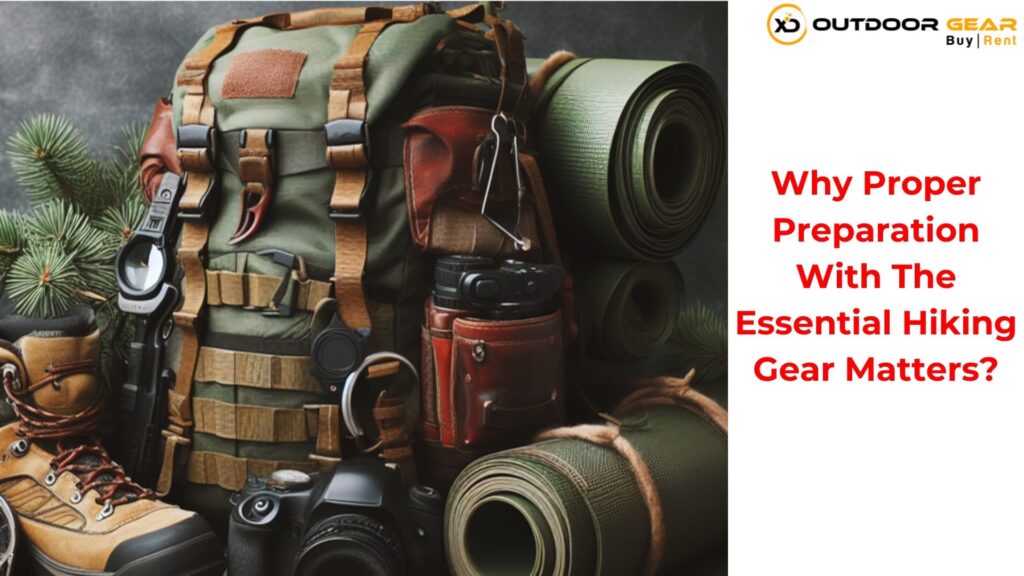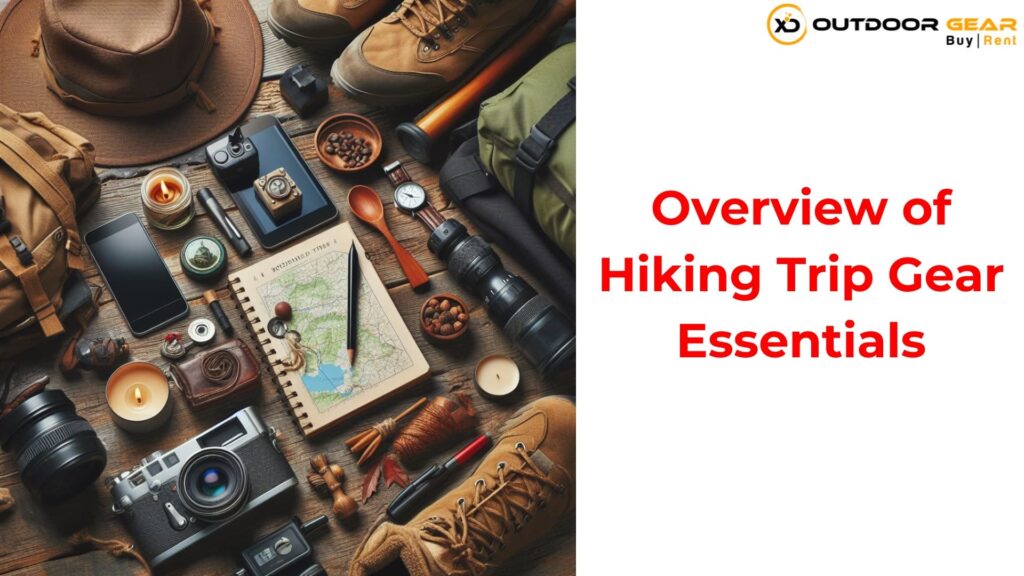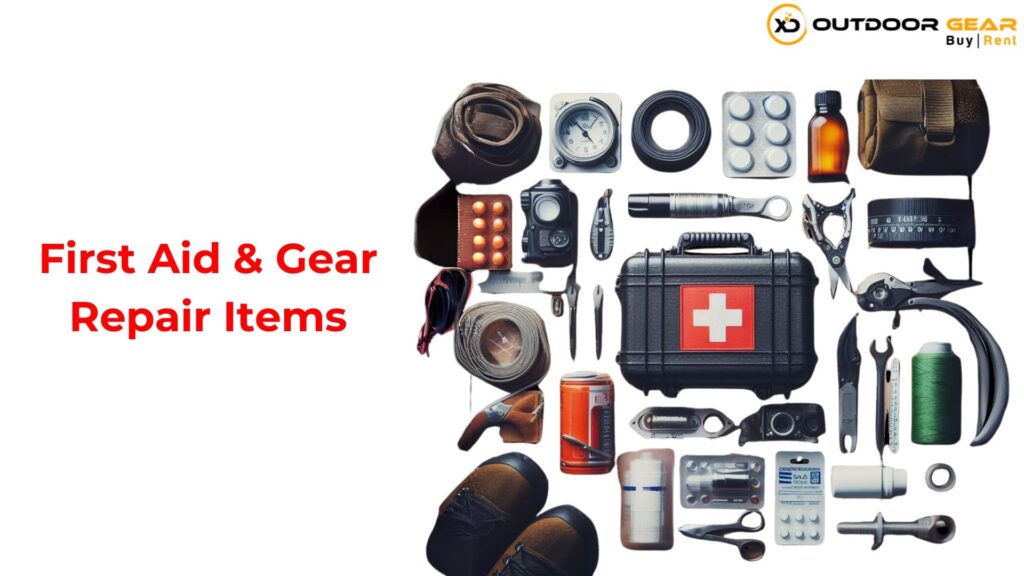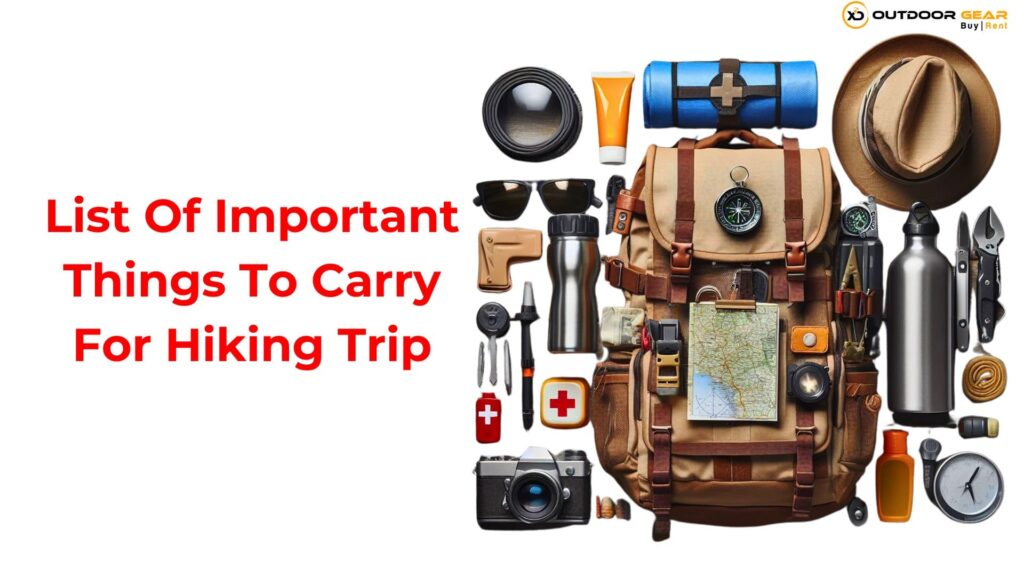Preparing a list of important things to carry for hiking to achieve a successful, comfortable, and safe hike. Hitting the trails for a peaceful hike through nature can provide beautiful vistas, fresh air, exercise, and adventure. However, improper planning and packing for the conditions can turn an ideal hike into an uncomfortable slog at best or a dangerous endeavor at worst. This comprehensive things to carry while trekking guide will equip you with the gear, clothing, navigation tools, nutrition, and skills needed to prepare properly for a hiking trip tailored to the duration and environment – whether a short day hike close to home or a multi-day backpacking trek through remote wilderness.
Why Proper Preparation With The Essential Hiking Gear Matters?

When venturing out into nature on foot, even for just a few hours, you lose the comforts and protections of infrastructure and potential access to help or resources compared to a standard everyday urban or suburban environment. Weather, wildlife, difficult terrain or an emergency medical issue miles from any trail head could lead to dangerous situations for hikers who don’t adequately prepare with appropriate gear for the conditions and realistic risks or occurrences.
Lack of sufficient equipment ranging from proper nutrient-rich foods, insulating outerwear, rain/wind protection and navigation tools can quickly turn an enjoyable hike into an extremely difficult, uncomfortable and hazardous scenario should inclement environmental conditions arise or an accident happens on the trail. For example, let’s say halfway up a long incline to an exposed peak in late fall conditions, dark clouds quickly blow in obscuring the path forward and a cold front drops the temperature while strong winds pick up. Without quick access to warmer layers, extra socks, rain shells or navigation tools to find shelter, hypothermia could set in making self rescue impossible.
Beyond safety and comfort considerations, not having certain preparation items and practices for Leave No Trace principles can severely degrade the natural environment hikers travel through. For instance, failing to properly dispose of human waste and toilet paper 添or pack out all trash you carried in could contaminate water sources sickening wildlife in the area. Similarly wandering off trail frequently damages surrounding soil, vegetation and habitats for many native species. Using harsh chemicals without 125 feet of water sources also pollutes ecosystems long term. Preparation shows responsibility towards the preservation of our shared public lands by packing out anything you bring in, covering waste properly using provided facilities when available and staying on established trails to minimize impact.
The exact combination of essential clothing, footwear, gear, tools, nutrition and other items to prepare with does vary substantially depending on the following hiking trip factors:
1. Duration & Distance – Shorter day hikes often allow hauling extra weight for more comfort-focused gear compared to extended miles over multiple days requiring strict rationing of pack weight.
2. Location & Conditions – Terrain, climate, altitude, season, and expected weather patterns determine the specific layering combinations, shelters, hydration, traction and insulation required unique to the twist and turns traversing each trail in a given region.
3. Group Size & Composition – For solo trips, redundancy across essential systems provides security in case anything fails. Hiking with kids or less experienced peers requires more safety tools and provisions proportional to everyone’s abilities and paces.
This guide covers recommendations spanning both quick suburban day hikes close to population centers all the way to extended remote expeditions through mountain ranges far from the nearest road access. The gear suggestions here focus on temperate climates during warmer months. Separate considerations at the end detail how to augment your essentials for extreme winter trekking, desert crossings or other challenging environments drawing from the author’s years as a hiking guide and enthusiast taking on diverse terrain.
Overview of Hiking Trip Gear Essentials

At a high level, recommended gear and tools to prepare for a hike map across four broad categories:
1. Hiking Apparel & Footwear – Moisture wicking clothes, insulating base and mid layers adaptable to dynamic temperatures in conjunction with weatherproof yet breathable outer shells plus sturdy hiking boots supporting traction over uneven ground during lengthy carries.
2. Packs & Carrying – Lightweight yet high capacity storage providing comfort with adjustable suspension systems to stabilize loads on the move ranging from 25 liters for short trips up to 60+ liters for extended self supported journeys off trail requiring camping gear.
3. Critical Safety Tools & Navigation – First aid, emergency blanket sleeping bag bivy multi-tool knife GPS satellite communicator maps compass headlamp flashlight water filter. Enough said.
4. Nutrition, Hydration & Health – The right balance of high energy rations, electrolyte supplementation mixed with water hauling capacity and purification mechanisms to fuel human output down miles of demanding terrain without taxing bodily systems.
Assembling the appropriate mix of durable clothing, shoes, storage transport, utility tools and sustenance centered around these pillars provides the greatest probability of comfort, safety and success when venturing out on foot into nature’s unpredictable domains. Now let’s unpack what specific items to prioritize within each gear category.
Hiking Clothes & Footwear
The first foundations involve wearing suitable hiking apparel and footwear providing insulation when cold, breathable cooling during heat while wicking away moisture and resisting external moisture all day supported by footwear stabilizing traction over irregular surfaces during lengthy carries.
Key Upper Body Hiking Clothing Items & Considerations
➤ Hiking Shirts – Breathable wicking materials releasing heat like polyester. Long sleeves protect skin from abrasion and sun but allow ventilation zip-offs. Solid colors and loose fits better conceal odors and dirt over prolonged use. Brands like Columbia, REI, Smartwool and Icebreaker offer great options.
➤ Hiking Pants – Look for light, flexible, abrasion-resistant pants offering weather protection if caught in elements while maintaining breathability. Integrated belts, discreet thigh pockets and partial elastic or adjustable ankle width help dial in fit for specific bodies in motion. Columbia and prAna designs excel here.
➤ Base Layers – Snug performance fabrics without restrictive compression keep moving skin dry and warm in cold through moisture transfer not absorption. Overlapping flat seam stitching prevents chafing under packs. Wool and synthetic blends breathe better than 100% cotton.
➤ Insulated Jackets – Lightweight down fill puffers with wind blocking DWR coating retain warmth even in moisture as insulation clusters maintain loft when wet. Synthetic Primaloft substitutes stand up to compressive strains of lugging packs resisting matting down. Hoods, zippered pockets and adjustable cuffs/hem essentials. Outdoor Research, Rab, Patagonia pedigree pieces recommended.
➤ Rain Shell Jacket & Pants – Ideal balances of breathability measured in average air permeable ratings like 10,000mm with water ingress protection levels of 15,000mm+. For sustained storms GoreTex Paclite, other proprietary membranes prove invaluable keeping dry without drenching out from interior perspiration. Durable water repellant (DWR) treatments enhance water beading flow off faces.
➤ Layering System – Having the ability to mix and match multiple tops & bottoms depending on variable temperature, wind, humidity and exertion profiles allows adapting to unpredictable conditions. Bring faster transitioning lightweight micro grid or fleece mid-layers for more range instead of bulky single pieces.
Leg Layers & Cold Weather Extras
➤ Under Base Layers – Overlapped flat locked seams prevents skin rubbing while maintaining next-to-skin moisture transfer drying properties. Merino wool and synthetic blends strike best balance across criteria. Bring a spare pair on extended outings.
➤ Convertible Layering Systems – Some pants come with integrated zip off thigh to calf cargo pockets doubling as storage and wind protection. Water resistant soft shell pulls over base layers blocking wind crossing high ridges.
➤ Cold Weather Extras – Light down or Primaloft insulated bib pants, knee high gaiters and extra base layer leggings prove invaluable during shoulder season cold snaps or frigid winter mountain conditions keeping snow and wind at bay.
Footwear: Boots & Socks
➤ Hiking Socks – Cushioning, fitted merino wool and alpaca blend socks prevent rubbing on uneven descents. Reinforced bottoms improve durability with breathable mesh zones cut down odor retention over consecutive long mileage days. Bring multiple pairs storing worn separately.
➤ Hiking Boots & Shoes – Light or mid weight traditionally laced up boots from salomon plus modern athletic crossover styles with proprietary fast lacing boa systems provide ankle support, locked in foot stability across uneven terrain and protect toe/heel strike zones from rock kicks. Deep aggressive lugs improve uphill/downhill traction over mixed surfaces.
➤ Snow & Winter Hiking Boots – Super insulation, peri-guard gaiter integration, heel/crampon compatibility and integrated gaiters make Scarpa, La Sportiva and Salomon styles ideal for cold weather traction. Removable insole air drying systems decrease overnight moisture buildup keeping feet warmer hour after hour. Artic shields block wind penetrating uppers.
Hiking Packs & Gear Transport
With footwear and apparel dialed towards variable conditions, sufficient storage capacity to haul necessary food, layers, shelter and tools comes next using packs properly distributing weight comfortable for lengthy carries.
Internal vs External Frame Packs
External frame packs position weight higher on torso enabling better stability during scrambling but limit close body agility through brush. Internal frames keep loads tighter paired across hips and shoulders for efficiency although require ingrained muscle memory to prevent backward falls. Modern internal frames dominate for all but hunting specific use cases.
Gear Capacity Range
Average pack hauling scope scales from tiny 12 liter “fast packing” vests up to gargantuan 100+ liter expedition haulers designed for extended unsupported polar or Himalayan range traverses though sweet spots emerge for typical 1-7 day recreational trips.
| Hiking Trip Duration | Recommended Pack Capacity |
|---|---|
| 1 Day Hike | 18-30 Liters |
| Overnight | 35-55 Liters |
| 3 Days or More | 50-75 Liters |
These volumes account for the total gear, water, and food needing room vertically and horizontally. Going too big poses weight penalties while skimping too small risks a lack of capacity even for essentials. Advanced ultralight through hikers trim base weights below 10 pounds enabling slimmer bags. Novices carry more bulk.
Backpack Features & Fit
➤ Suspension & Structural Support – Shoulder straps cushion bearing 25% of heft but not eliminating spine steadying hip belts sharing 40-60% force loads to legs leaving just residual sway for vertebral disks avoiding long term damage. Minimalist packs need properly strengthened core/glute fitness regimens before attempting 20 mile days. Sternum straps prevent single shoulder sag.
➤ Ventilation – Sweat soaked backs hike poorly shedding warmth. Increased air flow mesh padding segments provide necessary evaporative cooling and moisture mitigation particularly in hot humidity avoiding akward clamminess chafe reminiscent of Andy Dufresne’s prison break flee in Shawshank Redemption nightmares.
➤ Size/Torso Fit Adjustments – Packs scale across short, regular and long torso ranges with adjustable shoulder harness and hip belt rises to align with natural waist lines. Dangling straps throw off honorary balance. Test fittings assure proper arresting arm length reach and sub waist hip wrap preventing see-sawing spine tipping backwards. Expert specialty retailers assist getting proportions right before purchasing rather than blind online guesswork.
➤ Integrated Rain Covers – While silnylon, XPac and cuben fiber bag materials resist moisture saturation seepage themselves, dedicated elasticized storm covers stretching over entire lid, sides and bootom block sideways sheet flows from direct wind driving rain contact providing that extra assurance in the face of tempest downpours should they suddently unleash fury while exposed on ridge lines.
➤ Gear Access & Organization – Dual zippered sleeping bag compartments, side stuff pockets, dual tool loops, trekking pole fastening quivers and similar quick stash options prevent constant interior excavation fishing trips seeking buried items. Hip belt and shoulder strap pockets reinvent easily accessed snacks, phones and headlamps which otherwise settle entombed out of reach until camp.
Critical Gear, Safety Tools & Navigation
With apparel warmth and hauling capacity secured, selecting the right supporting accessories from navigation aids ensuring route certainty to emergency and repair implements averting crisis manifest next in sequence. Avoid skimping here.
Navigation Tools & Route Cerainty
Navigating through off trail terrain devoid of visible worn paths or sign posts and outside reliable GPS device or cellular service coverage requires map and compass proficiency. Similarly monsoon worthy rain and fog descends landscape obscuring visibility hours on end making preloaded GPS waypoint routing critical rather than hoping recognizable ridgelines emerge. Prepare assuming zero visibility white out conditions.
➤ Topographical & Specialty Printed Maps – Weatherproof tear resistant topographical maps constructed of Tyvek and clear film offer superior durability for extended trips compared to store bought paper versions vulnerable to moisture damage and lack appropriate backcountry details like trail junctions and camp locations. Proper scale ratios hovering around 1:50,000 highlighting 20ft contours prove sufficient without overwhelming complexity.
➤ GPS Devices/Apps – Dedicated handheld units like Garmin Fenix series smart watches come preloaded with enough basemap detail navigating most situations augmented by syncing more advanced breadcrumbs and waypoint routes via desktop softwares like CalTopo for unlimited annotation. Gaia GPS, Avenza and similarly featured apps overlay downloaded regional map data on smartphones minus connectivity needs. Both leave operational electronic failure risks GPS communicator.
➤ Compasses – Whether basic floating disk declinated or higher caliber adjustable global needles such as from Silva or Suunto, a final analog contingency stays secured when gadgets malfunction. Those also containing mirrored sighting levels and gradation slope calculators enhance terrain profile awareness for more advanced orienteering navigation practice.
➤ Altimeters – Measuring relative elevation gains and plateaus traveled proves mildly useful at times identifying vertical progress when dense tree canopies or cloud cover obscures visible peaks used for orientation clues during ascent. Mostly redundant alongside accurate topo and GPS charts except when validating progress in whiteouts.
➤ Satellite Communication/PLB Devices – When carrying children or hiking solo more than a few miles from heavily trafficked trails, consider provisioning Garmin InReach Mini, Spot or other satellite transponder messaging devices for check in and emergencies. Paired smartphones apps relay locations to monitoring parties activating rescues if injured or lost.
First Aid & Gear Repair Items

Preparing for accidents, injuries and broken gear failing miles from road access remains equally vital for group safety. Spare a thought for self rescue worst case scenarios apart from adrenaline rush objective summit pursuits or finish line fever ignoring nagging joint tweaks leading to blown knees cresting cairns when mild preventative actions alleviate suffering later. What emergency and repair tools merit pack space inclusion?
➤ First Aid Kit – Prepackaged adventure medical kits from Adventure Medical Kits offer shoulder friendly fanny pack form factors riding lumbar belt loops accessible when needed containing bandages, gauze pads, wraps, blister mitts, wipes, ointments and more upgraded with personal meds and tapes tailored each trip.
➤ Knives or Multi Tools – Small Swiss Army style multitools with pliers, screw drivers, bottle openers often satisfy majority of repair needs from stubborn zippers to jerry rigging broken pack chest straps MacGyver style using creative weaves saving long limp outs. Larger locking blade knives should pull double duty skinning game or building survival shelters too if planning extended side country forays possibly forced into unexpected corners.
➤ Fire Starting – From stormproof matches, peel shaving ferro rods bestowing 10,000 strike lifespans to USB rechargeable plasma lighters with adjustable torch strengths spanning candle modes to blowtorch intensities, pick your ignition poison for elevating morale during times of need. Cotton ball petroleum jelly accelerant tinder nests extend guarantees further.
➤ Headlamps – Those whiskey six sized led lamps strapping around domes seeing 100-300 lumen meters into night time paths as hands remain free scrambling terrain prove utterly essential when caught two hours past sundown rerouting failed summit bids better walking through dark than bivying above treeline. Red light modes prevent startling wildlife.
➤ Gear Repairs – Tenacious tape patches torn vestibules while black Gorilla brand duct tape performs miracles resuscitating failed frames and exploded bladders during prolonged expeditions testing mental fortitude and physical resilience beyond comfort zones. Skin bonding super glues cap minor gashes needing closure crossing medical divides. Zip ties, safety pins, replacement buckles, cordage, wire, carabiners and similar generalist tools empower jury-rigged solutions from hellish spots.
Responsible Backcountry Practices
While less dire or demanding mentally as finding routes or mending bodies, adopting sustainable human waste and trash packing practices when exploring natural places leaves positive lasting impact beyond fleeting social media inspiration porn for those eventually following similar callings. Prepare properly beginning each trip respecting environments passed through over years.
➤ Water & Camp Soap – Biodegradable leaves no traces on skin or site surfaces crucial when sponge bathing daily grime and sweat buildups away from scarce alpine lake sources sterilizing drinking hauls. Dr Bronner’s ® unscented castille bars check boxes foaming cleansers without nasty antibacterial chemicals degrading food chains. Colgate Wisps disposable toothbrushes supplement dental hygiene without lots of foaming paste residue.
➤ Waste Handling – Lightweight foldable shovels/trowels dig 6-8 inch deep catholes 200 feet from camps and water for burying human waste further decomposing under organic duff layers. Used toilet paper must remain contained inside spelled out WAG bags doubling as practical trash bin packing out sticky used substances unlike prominent misbehavior stories headlining ever-growing news reports questioning certain social media celebrities…
➤ General Trash – Whatever enters wild spaces returns home for proper landfill/recycling disposal not left roadside expecting others eventually shoulder irresponsible behaviors. Cigarette butts, banana peels and loose glitter degrade thousand year evolution.
Shelter, Bivouac & Warmth
Hopefully calamities never require utilizing last ditch shelter or signaling devices hiking mainstream trails though sufficiently determined peakbaggers pursuing alpine ridgelines with fast and light ambitions gamble with exposure assuming benign weather holds apostling obsolete mountaineering attitudes no longer acceptable as climate unpredictability increases yearly. Prepare always for worst case storms and cold fronts.
➤ Emergency Bivouacs – Mylar bivy sacks, both open and zippered models, theoretically provide hypothermia lifelines when trapped in open areas using inner body vapor barriers preventing heat robbing convection ejecting out sides. Fold integrated reflective shields retaining radiant warmth blocked from wind chill. Derivatives improve breatheability minimizing soggy inner condensation with air permeable panels.
➤ Insulated Variable R Value Sleeping Pads – Closed cell foams insulate from cold ground losing heat against bodies by trapping dead air cells as barriers. New inflatable designs adjust firmness hitting soft/hard optimized comfort preferences. Quilted baffle interiors prevent fluid sloshing while retaining shape weathering outside sharp objects.
➤ Mid Layers & Loose Fiber Insulation – Fluffier synthetic fills mimic natural down loft keeping stationary bodies warmer sans feathers collapse when damp. Wear hoodies, pants and booties stuffed inside bivys or waterproof outers mitigating convection leaks for dryer environs. Hot hands toe warmer packets boost blood flow retaining feeling in extremities prone to initial numbness then advanced frost nip tissue damage.
➤ Tents & Shelters – Freestanding single walled trekking pole supported tents for three season use most often suffice backpacking needs with adjustable ventilation options. More technical mountaineering oriented hardshells cater extreme weather and winter glacier endeavors specially strengthened resisting avalanche debris impacts.
➤ Satellite Communication & Rescue Devices – Alone never assumes connected coverage exists particularly ascending big vertical where dropped signal strength or masked sightline obstruction hampers radio communication. Battery powered satellite transponder beacons from ACR, Garmin and SPOT when paired to annual subscription monitoring services provide SOS peace of mind relaying GPS coordinates initiating search response teams for stabilization transport in dire breakdowns.
Nutrition, Hydration & Energy
Simply strapping proved proactive gear, clothing and tools heading paths into nature half fulfills equation measuring successful outdoor progress. Fueling exertion refining calorie intake, water needs and electrolyte balancing prevents crashing unprepared when either systems teeters exhaustion unable to shoulder simple final miles merciless exposed on empty ridges or valleys no longer buzzing previous momentum’s excitement. What food, drink and supplements deliver essential energy expected distances demand?
Hydration Planning & Water Sources
- Carrying capacity – Minimum 20-40 oz/liter water hourly rate needed factoring local climate, humidity and accessibility to purity verified refill spots.
- Container options – Durable aluminum, BPA plastic and collapsible soft packs ranging from .5L-3L capacities satisfy multi hour needs between replenishing clean streams, lakes and caches. Consider hands free hydration bladder reservoirs and drinking tubes for continual sipps accessing packs.
- Water purification – Chemical treatments, mechanical filters, UV light zappers and boiling guarantee eliminating biological contaminants like cryptosporidium, E. coli, giardia ensuring hydration health sans digestive misfortune doubling over trailside during crucial stretches. Sawyer Squeeze filters excel combining drinking straw functionality with budget friendliness.
- Electrolyte tablets – Replenishing depleted sodium, magnesium, potassium sweat emission levels keeps mind sharply thinking and muscles contracting fully over lengthy high output miles avoiding painful cramps.
Nutrition Planning Factors
- Caloric intake – Humans requires approximately 100-200 calories burned hourly with heavy packs, elevation gain and climate friction. 2,000+ calories daily minimum keeps functioning drawing from dense fatty nuts, packed proteins and simple carb pushers.
- Soylent & protein shake mixes provide lightweight vitamin fortified meals sans cooking fuel when only hot water accessed.
- Complex bars and gels digest slower metering glucose preventing insulin crashing bonking when pushed towards anaerobic thresholds mile after mile.
- Shelf stable safety – Pack cured meats, hard cheeses avoiding beasties and faster spoils in heat allowing longer duration provisioning between resupplies.
- Allergy avoidance – Carefully vet ingredients bringing Epipens and Benadryl if susceptible to airborne irritants or touch reactive swelling.
- Taste fatigue – Vary sweet, savory and spicy items keeping morale up when everything becomes mechanical putting heads down gritting over never ending ridgelines.
Gear Selection & Checklist Development
With environment apparel and conditions prepared for through equipment base layers and nutrition plus hydration balancing energy needs hiking sustainably, thoughtful checklist arrangements perfectly organize gear improving ingress/egress transitions when called for virtually eliminating frustrating searches digging blindly seeking specific items lost in the bags clouded tired minds grow sloppy setting up noisy campsites late night disturbing wildlife cycles not respecting darkness bedding hours after all. What organizational tips help?
Pack Sizing & Gear Volume Calculations
- Weigh all gear using a bathroom scale creating spreadsheet inventory even when estimations attempted
- Calculate total volume estimating how densely each item packs using set capacity containers to visualize spatial limitations
- Simulate gear packing order loaded vertically imagining stuff sacks rolling tight enough for lid closure
- Identify multi-use items avoiding unnecessary redundant tools saving weight and space
- Test run fully loading bags confirming volumes fit before field deploy to validate assumptions
Gear Storage & Access Optimization
- Use color-coded cubes, stuff sacks, and accessory pouches centralizing similar items like first aid, toiletries, repair tools etc enabling quickly gathering categories
- Front-load essentials accessible without unpacking entire contents when needed at moment’s notice during day hikes
- Ensure critical layers, storm shells and insulation sit atop both for external access but also for swing around retrieving compensation as weather suddenly shifts
- Wrap micro items like fire starting, small knives and lights with interior accessory straps stopping sinking bottom never finding them again when beyond hand’s reach packed under larger comparatively static duffel zones
Clothing Layer Optimization
- Beanie caps, neck gaiters, lightweight gloves and under layer tops make fine outermost additions allowing rapid adding or stripping adjusting comfort levels for alpine ridge ascents where temperatures gradient 20+ degrees Fahrenheit between mountain base and cloud skimming apex trips
- Variety of moisture wicking and fast drying technical fabrics prevents soggy cold clamminess while resisting saturation alternatively
Read also: 30 Things To Carry For Kedarkantha Trek
Specializing Gear Modifications For Conditions
Thus completes full cross section gear foundations applicable for majority overnight hikes crossing well marked trails and non technical terrain during favorable summer conditions but certain specialized gear better aids peakbagging remote glaciated mountaineers or extensive winter camping in regulated snow parks. Which modifications help?
Winter Alpine & Snow Gear Enhancements
- Forty below rated double boot systems with integrated under boot insulation wrapping feet fully
- Removable interior boot drying liners for multi day usage
- External bungie style crampon compatibility and improved forward flexion for steep grade icy slopes
- Gaiters or built in supersized side shielding preventing upward drift lodging temporarily maiming mobility critically when postholing suddenly up to waist through deceiving cornices and tree wells common early season before sufficient base pack refreezes continues holding weight
- Thicker four season freestanding tents or metallic heat reflecting emergency bivy sacks playing wind blocking insulation roles should fluky fronts barrel through unexpectedly stranding teams nearing peaks too ambitious for abilities
- Hand/Foot warmers packets lasting 6-10 hours self heating extremities high priority protecting fine motor skills manipulating locking carabiners, tying sturdy knots, igniting damp wood needed for melting snow to rehydrate food mixes cooked
- Insulated water bladder sleeves preventing tubes freezing delivering drinks on demand sliding under many shell layers keeping close enough not requiring extensive unpacking constantly frustrated accessing central hydration dominant in summer thinking
- Extending trekking poles improving downhill braking leverages for heavy packs wanting to accelerate out of control and shortened points provide self arrest stability planted augering increased bite traction tentative steep frozen angles
Desert & Global Hot Weather Essentials
- Focus hydration hauling sufficient water duration demands exploring notoriously dry unmarked cache zones like Sahara surveying weeks long
- Light colored thin loose fit clothing prevents skin frying covering extremities always unlike some venturing out clueless mid day egos skewing good judgement
- Electrolytically balanced drinks replenishing sodium magnesium potassium levels depleted rapidly compared to northern latitudes requiring increased attention physically monitoring early symptoms
- Packrafts enable floating previously impassable sand oceans avoiding relentless reflective heating with partial shade relief mid day when attaining refuge oasis or seasonal watering springs proves impossible determined crossings risking mirages misleading distances gauged by sight
- Orienteering navigation constantly confirming heading when few visual cues or definitive map marks exist particularly tall dune fields shifting relentlessly each storm obscuring established routes from return trips same year discovery documentary projects
- Emergency shelter from sweltering UV rays naps limited hours till continued night travel cooler temperatures but still requiring higher insulation values than assumptions compared granted always packing extra down layers justifying room.
FAQs about EssentialThings To Carry For Hiking
The “ten essentials” checklist includes – navigation (map, compass), sun protection (sunglasses, hat, sunscreen), insulation (extra layers), illumination (headlamp), first aid supplies, fire tools, repair kit/tools, nutrition (extra food), hydration (extra water), and emergency shelter (tent, bivy sack).
Choosing backpack capacity depends on trip duration and how much gear you need to carry. Good general capacity ranges are:
1. 15-30 liters for day hikes,
2. 30-50 liters for overnight
3. 50-80 liters for multi-day hiking
Test pack your gear and ensure everything fits before heading out.
Avoid wearing cotton shirts, pants, and underwear when hiking. Cotton absorbs moisture and dries slowly, which can cause chafing and hypothermia when it gets wet. Choose moisture-wicking synthetic or wool fabrics instead.
Pack at least 2-3 liters of water capacity for a full day’s hike. Carrying a hydration reservoir with a drink tube allows easy drinking access without stopping. Bring water treatment methods like filters or chemical tablets too.
Look for hiking shoes or boots with sturdy materials, ankle support, and rugged tread for traction and toe protection. Waterproof membranes like Goretex keep feet dry through streams and allow proper ventilation. Prioritize comfort with break-in periods.
Read also: 15 Best Trekking Destinations Near Bangalore For Outdoor Activities
Final Thoughts & Further Explorations
Recreating outdoors tests the mental resolve and physical stamina incredibly. As public lands expand access enabling deeper exploration beyond paved paths through ancient geographical wonders previously untracked by ancestors origins unknown, modern generations are drawn towards processes quantifying preparedness minimizing unnecessary risks balancing needs exploring sustainably chapter after chapter each trip’s story written. This guide arms essential knowledge and recommendations for doing exactly that when venturing out on foot through national parks or wildlife preserves. May the journey continue in good health having fun! Please share memorable moments and lessons learned packing along the way so more discover profound enrichment living simple backpacker lives with what carries through while there.




